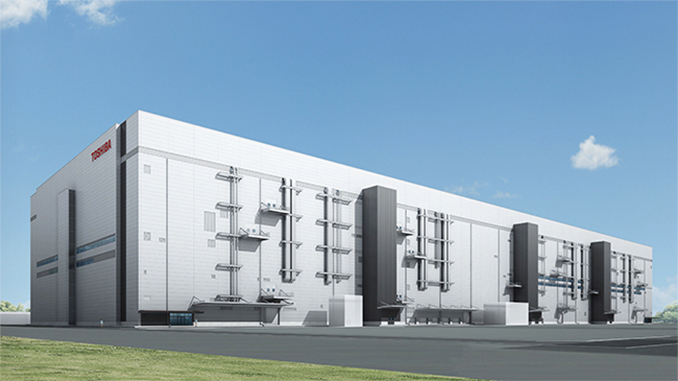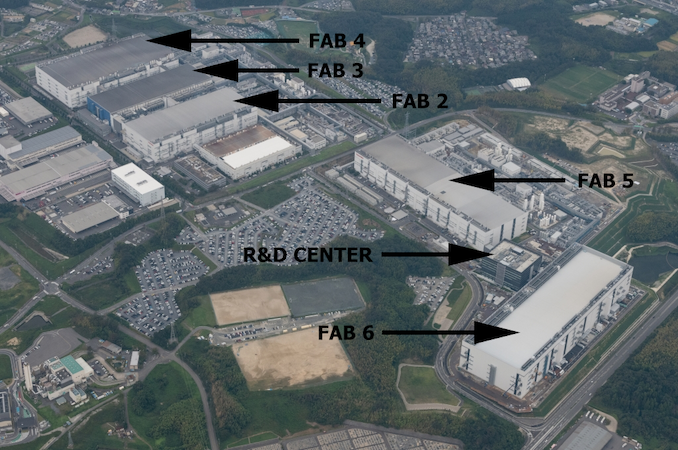Toshiba & WD NAND Production Hit By Power Outage: 6 Exabytes Lost
by Anton Shilov on June 28, 2019 12:15 PM EST
Toshiba Memory and Western Digital on Friday disclosed that an unexpected power outage in the Yokkaichi province in Japan on June 15 affected the manufacturing facilities that are jointly operated. Right now, production facilities are partially halted and they are expected to resume operations only by mid-July.
Western Digital says that the 13-minute power outage impacted wafers that were processed, the facilities, and production equipment. The company indicates that the incident will reduce its NAND flash wafer supply in Q3 by approximately 6 EB (exabytes), which is believed to be about a half of the company’s quarterly supply of NAND. Toshiba does not disclose the impact the outage will have on its NAND wafer supply in the coming months, but confirms that the fabs are partially suspended at the moment. Keeping in mind that Toshiba generally uses more capacity of the fabs than WD, the impact on its supply could be significantly higher than 6 EB with some estimating that it could be as high as ~9 EB.
Both companies are assessing the damage at the moment, so the financial harm of the incident is unclear. Not even counting potential damage to production tools and other equipment used at the fabs, 6 EB of NAND cost a lot of money. Furthermore, analysts from TrendForce believe that a consequence of the outage will be some loss of confidence from clients of both companies, which will have a financial impact as well.
The Yokkaichi Operations campus jointly owned and run by Toshiba and Western Digital produces about 35% of the global NAND output in terms of revenue, according to TrendForce. At present, the manufacturing base has five production facilities (Fab 2, Fab 3, Fab 4, Fab 5, and Fab 6) as well as an R&D center, all of which were affected by the outage. Three fabs within the campus produce 3D NAND flash, whereas another two are used to make special-purpose types of memory.
Considering the gargantuan size of the Yokkaichi Operations, disruptions of its supply will inevitably have an effect on 2D NAND and 3D NAND spot prices in the short-term future. Nonetheless, since contract prices have already been set for Q3 (and possibly Q4), they are not going to change. Meanwhile, it remains to be seen whether large customers will have to go shopping in Q3 or Q4 and affect prices on the spot markets further.
Considering that the Yokkaichi Operations produces at least 1/3 of the global NAND flash output (let’s assume that dollar share more or less corresponds to bit share) and half of its production for the quarter was lost because of the incident, this means that the industry will miss approximately 1/6 (or 16.5%) of the global NAND supply in Q3. Whether or not this will create a deficit on the market that will cause significant price hikes depends on multiple factors and is something that remains to be seen.
Related Reading
- Toshiba Memory and Western Digital Open Fab 6 and New Memory R&D Center
- Toshiba Memory & Western Digital Finalize Fab K1 Investment Agreement
- Toshiba Begins to Construct New BiCS 3D NAND Fab in Iwate Prefecture
- Toshiba Memory to Build New Fab to Produce BiCS 3D NAND
- Toshiba Finalizes Plans for New 3D NAND Fab: Coming Online in 2019
- Toshiba to Build New Fab to Produce BiCS NAND Flash
Sources: Western Digital, Reuters, TrendForce, Blocks & Files












148 Comments
View All Comments
GreenReaper - Sunday, June 30, 2019 - link
Disagree.RealBeast - Friday, June 28, 2019 - link
Ouch -- that's gotta sting a little, even for large corporations like Toshiba/WDC.Bravadu - Friday, June 28, 2019 - link
I forgot to calculate the $100 part so yeah, up to $600 million.It will actually be lower than $600 since a 1TB Toshiba SSD (Sabrent or Inland) retails for $100, but not that much lower. I would estimate somewhere between $400 to $500 million
eastcoast_pete - Friday, June 28, 2019 - link
Apparently, the power outage was quite widespread, and affected not just the fabs, but the entire area (and many thousands of residents of that province). That being said, I also couldn't help to think "what a coincidence", as Toshiba/WD had planned to reduce their 2D NAND output, and this was one way of getting it done, and, possibly, the insurance and power companies to pay for it. I don't work in that business, but I expect any insurance affected by this to hire a skilled investigative team before cutting a very sizable check.voicequal - Friday, June 28, 2019 - link
An uncontrolled plant shutdown is actually a fairly dangerous situation. It's not something you want to test your insurance with.DyneCorp - Saturday, June 29, 2019 - link
Oh please, just stop. Jesus Christ. You people are nuts.DigitalFreak - Friday, June 28, 2019 - link
Now we know where all the Fukushima Daiichi electrical maintenance workers went!voicequal - Friday, June 28, 2019 - link
Fukushima didn't have a chance no matter how well maintained the generators. While designed to survive an earthquake, they were never designed for a tsunami of that magnitude.rahvin - Friday, June 28, 2019 - link
And to point that out most of the generators (primary and backups) were actually destroyed by the Tsunami, by the time they were able to bring in emergency generators from offsite the plant was already in meltdown.evernessince - Tuesday, July 2, 2019 - link
This is technically not true at all. Had they used a thorium based nuclear reactor, a nuclear meltdown would have been easily avoidable.